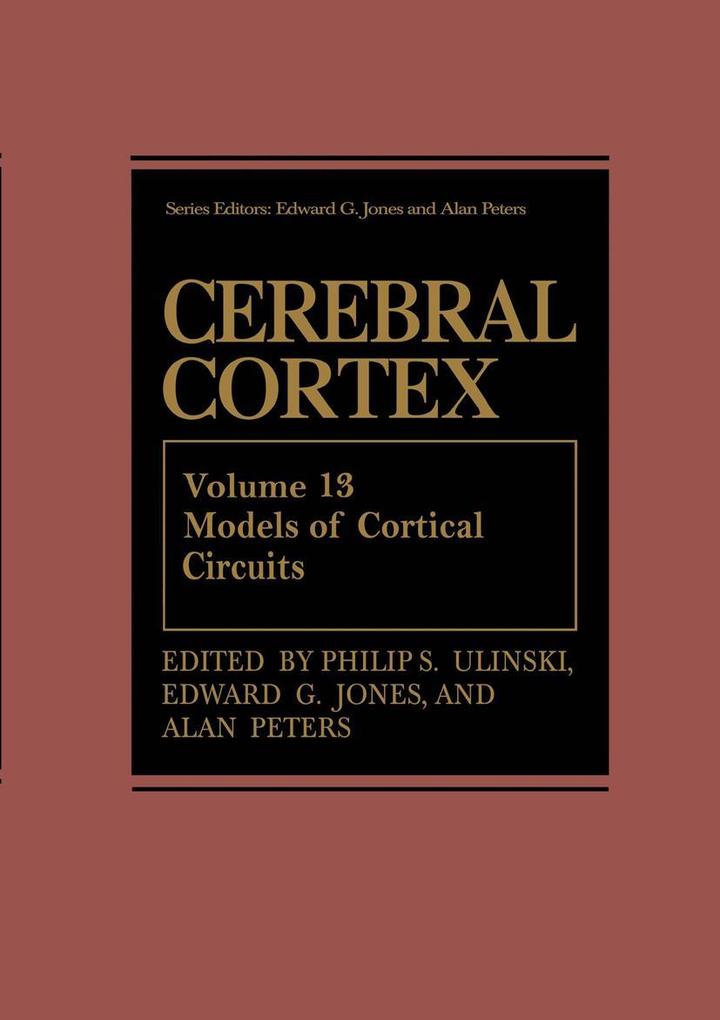
Zustellung: Mi, 30.07. - Fr, 01.08.
Versand in 2 Tagen
VersandkostenfreiBestellen & in Filiale abholen:
Thisisthefirstvolumeinthe CerelJral Cortexseriesdevotedtomathematicalmodels ofthecortex. Itwasmotivatedbytherealizationthatcomputationalmodelsof individualneuronsandensemblesofneuronsareincreasinglyusedinresearchon corticalorganizationandfunction. Thisis, inpart, becauseofthenowubiquitous presenceofpowerfulandaffordablecomputers. Suitablemachineswereformerly rareinresearchlaboratoriesandrequiredsubstantialprogrammingexpertisetobe usedinconstructingandusingneuronalmodels. However, computersarenow routinelyusedinallareasofneurobiologyandanumberofsoftwarepackagesallow scientistswithminimalcomputerscienceandmathematicalbackgroundstocon structseriousneuronalmodels. Asecondfactorleadingtotheproliferationof modelingstudiesisthedevelopmentoftechnologiesthatallowthekindsofdata collectionneededtodeveloprealisticmodelsofcorticalneurons. Characterization ofthekineticsofvoltage-andligand-gatedchannelsandreceptorshadbeenlim itedtorelativelylargeneurons. However, therapiddevelopmentofsliceprepara tions, patch-clampmethods, andimagingmethodsbasedonvoltage-sensitivedyes andintracellularcalciumindicatorshasresultedinasignificantdatabaseonthe biophysicalfeaturesofcorticalneurons. Thescopeofmodelingapproachestocorticalneuronsandfunctionsiswide anditseemednecessarytolimitthepurviewofthevolume. Thefocusisonattempts tounderstandthepropertiesofindividualcorticalneuronsandneuronalcircuitry throughmodelsthatincorporatesignificantfeaturesofcellularmorphologyand physiology. Noattemptwasmadetoincludemodelingapproachestounderstanding corticaldevelopmentandplasticity. Thus, workdealingwiththedevelopmentof oculardominancecolumnsandtheorientationselectivityofneuronsinvisualcortex isnotconsidered. Similarly, modelsdealingwiththecellularmechanismsunderlying long-termplasticityandwithapproachestolearningandmemorybasedonmodifica tionofHebbiansynapsesarenotconsidered. Relativelyabstractattemptstounder standhigherlevelandcognitiveprocessesbasedonneuralnetsrepresentasecond, majorareaofworkthatisnottreated. Modelsofcognitiveprocessesbasedon dynamicalsystemsmethodsinwhichnoattemptismadetoincludethebiophysical featuresofindividualneuronsarealsonotconsidered. vii viii Thetenmajorchaptersfallintothreegroups. Thefirstgroupdealswith compartmentalmodelsofindividualcorticalneurons. LyleBorg-Grahamprovides PREFACE anintroductiontothemethodsinvolvedinconstructingcompartmentalmodels andthenreviewstheexistingmodelsofhippocampalpyramidalcells. Becauseof theeffectivenessofhippocampalslicepreparations, theseneuronshavewell-ehar acterizedbiophysicalproperties. Thischapterillustrateshowcompartmentalmod elscanbeusedtosynthesizeexperimentaldataandprovideanintegrativeviewof thepropertiesofindividualneurons. PaulRhodescontinuesthethemebyfocusing ontheroleofvoltage-gatedchannelslocatedonthedendritesofcorticalneurons. Thisisanareainwhichtechnologicaladvancesinthevisualizationofneuronsin slicepreparationsbasedoninfraredmicroscopyhavegreatlyexpandedtheinfor mationavailableondendriticfunctioninjustafewyears. Thechapterbothreviews theexperimentaldataonactivedendriticconductancesandemphasizestheirpo tentialfunctionalroles. Thesecondgroupofchaptersdealwiththegenerationofreceptivefield propertiesofneuronswithinvisualcortex. Theyaddressissuesstemmingfromthe originalattempttounderstandhowthereceptivefieldpropertiesofneuronsincat andmonkeyprimaryvisualcortexaregeneratedbyinteractionsbetweengenicu lateafferentsandcorticalneurons. ThechapterbyFlorentinWorgotterevaluates modelsthathavebeenusedtoanalyzethegenerationofreceptivefieldproperties. RodneyDouglasandhiscolleaguesaddressaspecificsetofissuesdealingwiththe roleofintracorticalexcitationmediatedbypyramidalcellcollaterals. Animportant featureofthischapterisitsrelationtoattempttoconstructfabricatedcircuitsthat duplicatethefunctionsofcorticalcircuits. ThechapterbyPhilipUlinskifocuseson thegenerationofmotion-selectivepropertiesincorticalneurons. Itseekstoidenti tycellularmechanismsusedbyneuronsthatrespondpreferentiallytovisualstimuli movingwithparticularspee
Inhaltsverzeichnis
1 Modeling Cortical Circuitry: A History and Prospectus. - 1. Introduction. - 2. Lorente de Nó through Dynamical Systems Models. - 3. Hodgkin and Huxley through Network Models. - 4. Prospectus. - 5. References. - 2 Interpretations of Data and Mechanisms for Hippocampal Pyramidal Cell Models. - 1. Introduction. - 2. The Database for Single-Neuron Models. - 3. Strategies for Single-Neuron Models. - 4. Anatomy and the Model: Data and Methods. - 5. The Linear Model: Data and Methods. - 6. Phenomenological Templates. - 7. Review of Hippocampal Models. - 8. Channel Models. - 9. Ionic Concentration Dynamics. - 10. Nonsynaptic Channels of Hippocampal Pyramidal Cells. - 11. HPC Sodium Channels. - 12. HPC Calcium Channels. - 13. HPC Potassium Channels. - 14. Nonspecific Cation and Chloride Currents. - 15. Simulations of HPC Properties with the Working Model. - 16. References. - 3 Functional Implications of Active Currents in the Dendrites of Pyramidal Neurons. - 1. Introduction. - 2. Historical Perspective. - 3. Amplification of Synaptic Inputs. - 4. Compartment Model Simulations of Amplification. - 5. Effects of Dendritic Active Currents on EPSP Shape. - 6. The Effect of Dendritic Active Currents in Shaping the Intrinsic Firing Properties of Pyramidal Cells. - 7. Effects of Potassium Currents. - 8. Linking Firing of the Soma to Depolarization at Distal Synapses and the Implementation of Hebb s Hypothesis. - 9. Apologies. - 10. Concluding Observations. - 11. References. - 4 Comparing Different Modeling Approaches of Visual Cortical Cell Characteristics. - 1. Introduction. - 2. Foundations. - 3. Models of Cortical Orientation Specificity. - 4. Concluding Remarks. - 5. Appendix. - 6. References. - 5 The Role of Recurrent Excitation in Neocortical Circuits. - 1. Introduction. - 2. Wiring Neocortical Circuits. - 3. CanonicalMicrocircuits. - 4. Units of Construction of the Basic Cortical Circuit. - 5. The Neuronal Components of Layer 4. - 6. Computation of Orientation. - 7. Noise and Restoration. - 8. References. - 6 Neural Mechanisms Underlying the Analysis of Moving Visual Stimuli. - 1. Introduction. - 2. A Primer of Basic Concepts. - 3. Neural Mechanisms: Mammals. - 4. Neural Mechanisms: Turtles. - 5. Conclusions and Future Directions. - 6. References. - 7 Linearity and Gain Control in VI Simple Cells. - 1. Introduction. - 2. The Linear Model of Simple Cells. - 3. Some Linear Properties of Simple Cells. - 4. Biophysics of the Linear Model. - 5. Some Nonlinear Properties of Simple Cells. - 6. The Normalization Model of Simple Cells. - 7. Testing the Normalization Model. - 8. Biophysical Plausibility of the Normalization Model. - 9. Conclusions. - 10. References. - 8 Non-Fourier Cortical Processes in Texture, Form, and Motion Perception. - 1. Introduction. - 2. Analysis of Texture Boundaries by Non-Fourier Mechanisms. - 3. Area V4 Neurons and Form Vision. - 4. Two-Dimensional Motion. - 5. Discussion. - 6. References. - 9 Modeling Thalamocortical Oscillations. - 1. Slow Thalamic Rhythms. - 2. Thalamus as Magnet for Modeling Dynamics and Neural Systems. - 3. Early Modeling Predicted a Role for Inhibitory Phasing. - 4. Modeling the T Channel. - 5. Modeling the Low-Threshold Spike. - 6. The Basic Two-Neuron Network. - 7. The Search for Origins: Whence Spindling? . - 8. Synchrony and Spread of Network Activity. - 9. Summary and Conclusions. - 10. References. - 10 Realistic Network Models of Synchronized Oscillations in Visual Cortex. - 1. Introduction. - 2. Model Structure. - 3. Model Results. - 4. Conclusion. - 5. References. - 11 Modeling the Piriform Cortex. - 1. Introduction. - 2. Summary of Data Being Modeled. - 3. Modeling ofPhysiological Data. - 4. Modeling of Functional Hypotheses. - 5. Summary and Future Directions. - 6. References.
Produktdetails
Erscheinungsdatum
27. September 2012
Sprache
englisch
Untertitel
Models of Cortical Circuits.
Softcover reprint of the original 1st edition 1999.
XXI, 573 p.
Sprache: Englisch.
Auflage
Softcover reprint of the original 1st edition 1999
Seitenanzahl
600
Reihe
Cerebral Cortex
Herausgegeben von
Philip S. Ulinski
Illustrationen
XXI, 573 p.
Verlag/Hersteller
Produktart
kartoniert
Abbildungen
XXI, 573 p.
Gewicht
1112 g
Größe (L/B/H)
254/178/33 mm
ISBN
9781461372233
Entdecken Sie mehr
Bewertungen
0 Bewertungen
Es wurden noch keine Bewertungen abgegeben. Schreiben Sie die erste Bewertung zu "Cerebral Cortex" und helfen Sie damit anderen bei der Kaufentscheidung.










